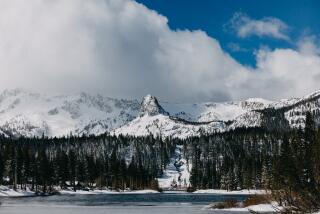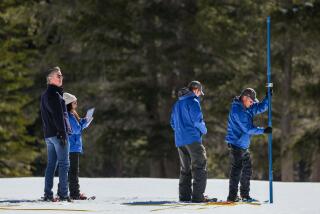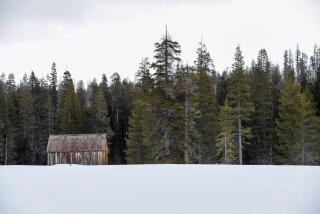The Kings River flooded from snowmelt that couldn’t be measured or predicted
The flooding that displaced residents in 90 homes along the Kings River in the Central Valley over the weekend was more than a week in the making.
For eight consecutive days last week, temperatures from Fresno to Bakersfield exceeded 100, according to the National Weather Service.
Wildfires burned, utility providers warned of possible blackouts because of a surge in demand, and thousands of feet up in the Sierra Nevada — far from where humans and their scientific tools could reach — California’s historic snowpack continued to melt. Even at Wishon Reservoir at 6,500 feet elevation, the mercury hit 91 degrees last week, the National Weather Service said.
The melting snow was in places so remote, in fact, that state flood management officials had no way of knowing how deep it was and how fast it was melting into reservoirs and canyons, experts said.
At Pine Flat Lake at the foot of the Sierra Nevada in Tulare County, engineers were forced to increase outflows from the reservoir into the Kings River as melting snow poured in at an overwhelming rate.
Farmers depend on the reservoir to irrigate their land, so engineers have to find a balance between holding enough water for irrigation later in the year and releasing enough to have room for snowmelt.
Over the weekend, that increased outflow from Pine Flat Lake reached Kingsburg, where it breached the riverbank and displaced people from 90 homes, damaging seven of them. It also put a golf course under 10 feet of water and flooded 18 recreational vehicles.
Residents were evacuated from the unincorporated area surrounding the golf course just north of State Highway 99 about halfway between Tulare and Fresno. Voluntary evacuations were advised in a wider area to the north and south of the golf course.
Though the evacuations have been lifted and people were returning home Monday, there’s still a question of what another heat wave will bring. The snow sitting at the highest peaks of the Sierra Nevada are currently immeasurable by land-based instruments, and after one of the wettest winters in California’s recorded history, experts say there’s no way to know exactly how much is left to melt.
“Most of the [snowpack] sensors are showing zero or have stopped working,” said David Rizzardo, water supply forecasting chief for the Department of Water Resources. “I’m out of clues.”
Before this weekend’s flooding, experts have warned that the state’s 100-year-old method of detecting and forecasting snowmelt is coming up short. Forecasters are relying on historical records to provide estimates on snowmelt, but they can’t account for climate change, experts say.
“The water keeps coming off [the mountain] faster than anybody thinks and it keeps going up and up,” Rizzardo said.
NASA’s Airborne Snow Observatory will fly several missions over Sierra Nevada watersheds this week to give water managers an estimate of what’s up there, Rizzardo said.
The National Weather Service did its best to warn residents ahead of the potential flooding. It posted a warning early Saturday that said, “Dangerously high water flows along the Kings River will continue to threaten communities downstream of Pine Flat Dam. Locations impacted include, but are not limited to: Minkler, Reedley, Kingsburg, and Grangeville.”
The notice said high releases were expected to continue through the weekend “as Pine Flat Lake is near its storage capacity due to ongoing snowmelt.”
It takes about a day for Sierra Nevada snowmelt to reach a reservoir, then another day or two before it hits Central Valley towns below the foothills, Rizzardo said.
KFSN-TV in Fresno reported Thursday that water is stressing levees downstream. Near Lemoore, workers with the Kings River Conservation District rushed to fix a 40-foot levee break that allowed water to gush into about four acres of alfalfa fields.
And where they’re not posing flood dangers, the rivers are killing people. Multiple drownings have been reported this year along the San Joaquin, Tulare and Kern rivers, among others, attributed to deceptively cold, fast currents.
Virtually every major river receiving water from the Sierra Nevada also provides some irrigation for the farmers below, and all are running at least 150% above their seasonal averages, DWR data shows. The Kings River was running at 257% Monday, Rizzardo said.
“It’s probably going to remain like that for a couple of days,” Rizzardo said.
Temperatures are expected to cool through Wednesday, followed by another warm pattern across Central California, the National Weather Service said.
But water managers aren’t fazed.
John Paasch, program manager for DWR’s flood operations, said the peak of California’s snowmelt has already passed.
“We won’t see the snowmelt inflows get back up to where they were this last week,” he said. “We would expect that all rivers downstream of those reservoirs will start to recede … we should be on our way down.”
A multi-year study led by NASA is underway to perfect the technique for measuring snowpacks worldwide.
Times staff writer Doug Smith contributed to this report.
For breaking California news, follow @JosephSerna on Twitter.
More to Read
Sign up for Essential California
The most important California stories and recommendations in your inbox every morning.
You may occasionally receive promotional content from the Los Angeles Times.










